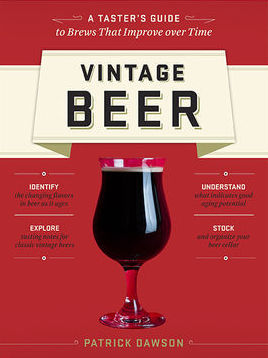Vintage Beer Hits the Mainstream

In Patrick Dawson's new book Vintage Beer: A Taster's Guide to Brews that Improve Over Time, the North Denver Tribune's beer columnist sings the praises of cellaring beer and aims to prove old beers are the best beers. Before reading on, a caveat: Beware, beer snobs! Vintage Beer is about aging craft beers and taking DIY to heart. The bottom line: Patrick loves him some brewski, but at the end of the day “its an adventure and its just beer”.
We sat down with Dawson to get the scoop on the new book, score some beer aging tips, and discover Catherine the Great’s love of English stouts.
How did your journey in beer cellaring begin?
At a Christmas get-together someone brought an aged Magnum and I’d kind of heard of aging beer before but had never really thought about it. Duval is a beer I love, one of my favorite Belgian beers and when I heard it was an aged version I was dubious. I thought: ‘Why would you age that beer? That beer is amazing.’ But I tried it and I was blown away by the flavors. They were fantastic and that just got me hooked. I really was in a bad way. I was like, ‘All beers must get better with age!’ And I just started doing it. Those first couple years were very difficult, painful years. I was drinking lots of really bad beer that did not turn out so well.
Any memorable successes amidst the early failures?
I think the beer that really did it—‘cause I was getting really down on it, like I was just wasting my time—was a beer from Avery. They make this one beer, Samael, with a massive alcohol content of 14%. Its so important with non-sour beers that they be really, really strong and this one just tasted horrible. It was like vanilla cough syrup. I aged it for four years it was one of the best beers I’ve ever had in my life. These dried fruits, caramel, figs, prunes, raisins- all this stuff. But then it had this bread pudding-like flavor that was…so cool, so much fun to know just how FAR it had developed. For me, one of the things I really like about aging beer is you get to put your thumbprint on the beer. I’m sure a lot of brewers would argue with that but I feel like ‘Hey I created this beer!’ If I hadn’t aged this, it wouldn’t be here today.
How long have people been intentionally aging beers?
I mean its been going on for centuries in terms of English beers—in my mind one of the first aged beers was the Russian Imperial Stout. Basically, Catherine the Great’s court in Russia adopted a fondness for English stouts and wanted them imported over to Russia. Higher alcohol content, more additional sugars—they had all the things you need for a beer to improve with age. It took usually a year or so for the beer to make it over to Russia. They discovered, ‘Hey there are all these new awesome flavors in here!’ Its just been in the last two years that aging beers has been mainstream—like when I was writing the book it was such a minor thing I hardly even mentioned it. Now breweries are aging on-site and releasing aged versions of their beers and they are a year or two old by the time they ever hit the liquor store shelf.
What’s it typically like when you’re really stoked for a beer when you take it out of the cellar to try it?
For beers where I have one or two huge bottles— which is usually the case because there are so many beers I want to try— I’ll have some buddies over. When people are around its fun because you are drinking the beer together and you are talking about it. Its like, ‘Whoa I never would have noticed that if you hadn’t mentioned it!’ There's a whole new frontier of flavors with aged beers. And I’ve been drinking beers for quite a while and I thought I knew all the stereotypical flavors but I definitely didn’t. You have a whole new vocabulary for all these flavors.
How has beer culture changed since you started writing about breweries and brews?
A few years ago, most people would be like ‘Oh I love Guinness, like those types of beers, and that was the beer geek. I’ve gotten spoiled living here in Denver and Portland’s the same thing. No matter what bar you go to there is always gonna be some really good beer on tap and that just didn’t used to be the case. Everybody has, even just the average Joe, know the different beer styles. You know, they know the IPAs, they know what hops taste like and the difference between hop flavor and aroma. The one thing I don’t like is this emergence of the beer snob, which I cannot stand. It’s a very fine line between a beer geek and a beer snob. People get all snooty and I’m just like if you like Bud Light Lime more power to you. Awesome. Just drink what you like. That’s my biggest thing.
Aging Basics:
- 50-60° F. at constant temperature
- Use an interior closet or crawl-space for a cellar
- Use insulated Styrofoam cases to protect your bottles
- Use beer with a high alcohol content (8-12%)
- Sour beers, lambics, and smoked beers are great starters
